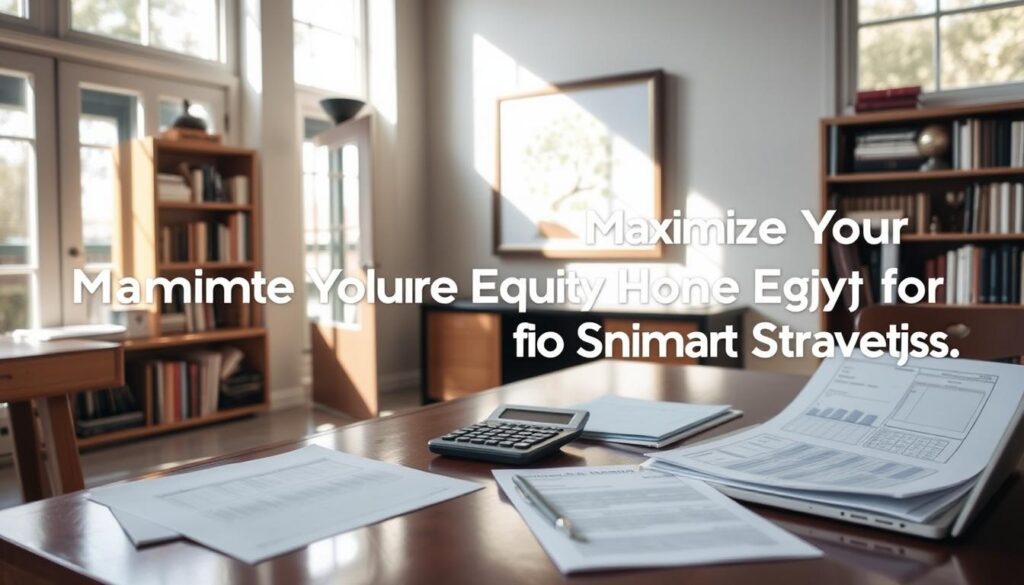Did you know the average U.S. home has gained $150,000 in equity over the past 10 years? Unlocking this hidden wealth starts with mastering the secrets of home equity investment. This guide reveals how to turn your property into a financial powerhouse using proven strategies from experts like xpertRealtyMarketing and Defy Mortgage.
Whether you’re aiming for profitable home equity or a successful home equity investment, this article breaks down how market trends, smart renovations, and smart financing can boost your net worth. Learn actionable steps to grow your equity from day one and avoid common pitfalls holding you back.
Understanding Home Equity: The Foundation of Investment
Home equity basics start with knowing what you own. When you buy a home, your understanding home equity becomes key to long-term financial growth. Equity is the portion of your home’s value you truly own, growing as you pay off loans or market values rise.
Defining Home Equity
Equity = Home’s Current Value – Outstanding Mortgage Balance. For example, a $300,000 home with a $200,000 remaining loan gives $100,000 equity. This number grows as you pay down your mortgage or improve your property.
Building Your Equity from Day One
Start smart with these strategies to build equity early:
- Make a larger down payment to reduce principal owed
- Pay extra toward your mortgage principal monthly
- Invest in upgrades that boost your home’s appraised value
A table shows how different methods impact growth:
| Method | How It Works | Benefits |
|---|---|---|
| Extra Payments | Reduces loan balance faster | Increases equity yearly |
| Home Improvements | Adds value to your property | Potential for higher resale prices |
| Market Appreciation | Area growth lifts home value | Passive equity gains over time |
Every choice you make—from monthly payments to smart upgrades—shapes your equity journey. Start today to see your investment grow steadily.
Evaluating Your Home’s Equity Potential
To unlock the home equity potential of your property, start by understanding how assessing home value works. Local real estate trends, property upgrades, and neighborhood demand all shape your equity’s growth. Regular property equity evaluation ensures you’re aware of opportunities to maximize returns.
- Recent home sales in your area
- Updates to your home’s features
- Local economic shifts
Professional appraisers provide precise property equity evaluation reports. Tools like Zillow’s Zestimate or Redfin’s Home Value Estimate give instant insights. Compare these with historical data to see if your home’s value aligns with market trends.
Location matters most. Homes in growing neighborhoods often have stronger home equity potential. Check for new businesses, schools, or transit projects nearby. These changes can boost your home’s appeal and value over time.
Regular check-ins help you spot growth opportunities. Even small improvements, like modernizing a kitchen, can shift assessing home value calculations. Stay informed to turn your property’s strengths into long-term financial gains.
Step-by-Step Guide to Assessing Your Property Value
Understandingproperty valuationstarts with a clearmarket analysis. Start by comparing recent home sales in your neighborhood. Look for properties similar to yours in size, age, and features. Online platforms like Zillow or Redfin provide easy access to this data.
Market Trends Analysis
Follow these steps for accurateassessing property value:
- Track sales of comparable homes over the past six months.
- Note trends in price changes—rising or falling values.
- Check interest rates and economic forecasts affecting buyer behavior.
Impact of Local Developments
Local projects can boost or lower your home’s worth. Consider:
- New schools or highways increasing demand.
- Zoning changes altering neighborhood use.
- Commercial expansions or environmental concerns.
| Factor | Impact on Value |
|---|---|
| New park nearby | +5% to +12% |
| Increased traffic | -3% to -8% |
| Renovated public transit | +7% to +15% |
Regular updates on these factors keep yourproperty valuationaligned with reality. Stay proactive—local newspapers and city council meetings are great resources. Small details today mean big differences tomorrow.
Navigating Financing Options and Strategies
Choosing the right financing options starts with understanding your loan programs. Every decision impacts your equity growth and monthly budget. Let’s break down your choices and how interest rates shape your plan.
Exploring Loan Programs
Three main home financing strategies stand out:
- HELOC (Home Equity Line of Credit): Access funds like a credit card with a variable rate
- HELOAN: Fixed-rate loans for lump-sum payments
- Cash-out refinance: Replace your current mortgage for instant cash

Understanding Interest Rates
Interest rates determine how much you pay over time. Adjustable rates shift with the market, while fixed rates stay steady. For example:
- HELOCs often have variable rates tied to prime rates
- HELOANs offer fixed rates for predictable payments
Shop around for the best terms—banks like Chase or Bank of America may offer different interest rates based on your credit score.
Compare quotes and timelines to pick a loan program that matches your cash flow goals. Lower rates mean higher equity retention over time.
What Makes a Home Equity Investment Successful? Key Factors to Consider
Unlocking equity success factors starts with understanding the core elements that drive home investment success. Let’s explore the key equity investment factors that separate profitable ventures from underperforming ones.
- Market Timing: Track trends to buy, sell, or refinance when demand peaks. For instance, regions like Austin or Seattle often see spikes in home values during tech booms.
- Strategic Renovations: Focus on upgrades that add value, such as modern kitchens or solar panels. Studies show energy-efficient homes command 9% higher resale prices.
- Loan Strategy: Compare loan programs like HELOCs or cash-out refis. Lower interest rates cut costs, boosting net equity gains.
These factors interact closely. A timely renovation during a rising market, paired with favorable loan terms, maximizes returns. For example, a 2023 study by the National Association of Realtors found that homes with updated bathrooms sold 15% faster in competitive markets.
Proven tactics include monitoring local zoning changes—like new schools or transit projects—that boost property values. Combining these key equity investment factors creates a roadmap for steady growth. Remember: patience and research are your best tools to avoid overpaying or misplacing funds.
Practical Tips for Boosting Your Home’s Equity
Small but strategic changes can make a big difference in boosting home equity. Focus on upgrades that blend style, function, and market appeal. Let’s explore proven methods to maximize your property’s value.
Renovation Ideas
Smart renovation ideas boost both livability and resale appeal. According to Bankrate, a classic wood deck recoups nearly 83% of its cost, while garage door replacements can deliver a 194% return. Prioritize high-impact spaces like bathrooms or kitchens, which often see strong ROI. For example, an upscale bathroom remodel offers over 45% value recovery.
Energy Efficiency Upgrades
Invest in energy efficiency upgrades to cut bills and attract eco-conscious buyers. Installing new insulation or ENERGY STAR-rated windows can slash utility costs while enhancing long-term equity. Even minor fixes like sealing air leaks or adding smart thermostats improve a home’s energy profile. These upgrades signal cost savings to future buyers, making your home more competitive.
Curb Appeal Enhancements
First impressions matter. Boost curb appeal with fresh paint, modern lighting, or well-maintained landscaping. A tidy front yard or updated front door can signal care and quality. Prioritize low-cost improvements like pathway repairs or mailbox upgrades to create immediate visual impact.
Combining these strategies turns your home into an asset that grows steadily over time. Every thoughtful upgrade strengthens your equity and marketability without overextending your budget.
Leveraging Tax Advantages and Incentives
Maximizing your home equity investment doesn’t stop at renovations or market timing. tax advantages and tax incentives can cut costs and boost returns. Many homeowners overlook these opportunities, but understanding federal and state options ensures you don’t miss out.
Federal Deductions
- Mortgage interest tax incentives may reduce taxable income.
- Property taxes often qualify as federal deductions when itemizing.
- Energy-efficient upgrades might qualify for federal credits, lowering tax liability.
State and Local Benefits
States offer unique state tax benefits, like exemptions for senior citizens or first-time homeowners. Check if your state allows deductions for:
- Renovation-related property tax relief
- Local improvement grants tied to community projects
Consult a tax advisor to align deductions with your strategy. Resources like HEIexplained’s guides clarify how tax advantages apply to your region. By combining federal and state options, you turn tax rules into a tool for growth.
Risk Management in Home Equity Investments
Home equity investments offer growth potential, but risk management is key to protecting your finances. Even with strong strategies, home equity risks like market shifts or financial instability can arise. Here’s how to stay secure:
- Fluctuating interest rates: Track market trends to avoid sudden payment spikes. Monitor rates and consider fixed-rate loans to lock in terms.
- Market downturns: Diversify your portfolio. Relying solely on home value for wealth can leave you exposed during economic slumps.
- Overleveraging: Borrow only what you can repay. High debt strains budgets and jeopardizes property ownership.
Proactive managing investment risk starts with a financial buffer. Keep an emergency fund covering 6–12 months of expenses. Regularly review loan terms and consult a financial advisor to adjust strategies. By balancing ambition with caution, you turn risks into manageable hurdles—not setbacks.
Success Stories and Case Studies
Discover how others turned equity into opportunities through success stories and case studies. These real-life examples show proven strategies for growing wealth and avoiding common pitfalls.
Real-Life Examples
| Scenario | Strategy | Outcome |
|---|---|---|
| Denver homeowner | Used HELOC for kitchen upgrades | Added $45k to home value in 18 months |
| Miami investor | Refinanced to fund rental property purchases | Generated $22k annual passive income |
| Seattle couple | Installed solar panels and smart home systems | Sold home for 15% above market average |
Lessons Learned
- Focus on high-demand upgrades like kitchens and bathrooms
- Work with certified contractors to ensure ROI
- Monitor interest rates before tapping equity
These inspiring home equity stories prove that with the right approach, equity can become a powerful financial tool. Study these lessons learned to apply proven methods to your own goals.
Conclusion
Every home equity investment journey starts with knowledge. This home equity conclusion reinforces how assessing your property’s value, choosing the right financing, and making smart upgrades can turn your home into a profitable asset. By following the steps outlined—from evaluating market trends to leveraging tax incentives—you lay the groundwork for a solid return.
Final home equity tips stress the importance of staying informed about local developments and interest rates. Prioritizing energy-efficient upgrades or curb appeal enhancements can amplify your home’s worth. Remember, investing conclusion means balancing risks like market fluctuations with opportunities like loan programs from institutions like Fannie Mae or Freddie Mac.
Take the first step today by reviewing your equity potential. Consult professionals like certified appraisers or FHA-approved lenders to refine your strategy. Whether renovating, refinancing, or planning for the future, your decisions now shape long-term gains. Start applying these strategies to build wealth wisely and securely.



